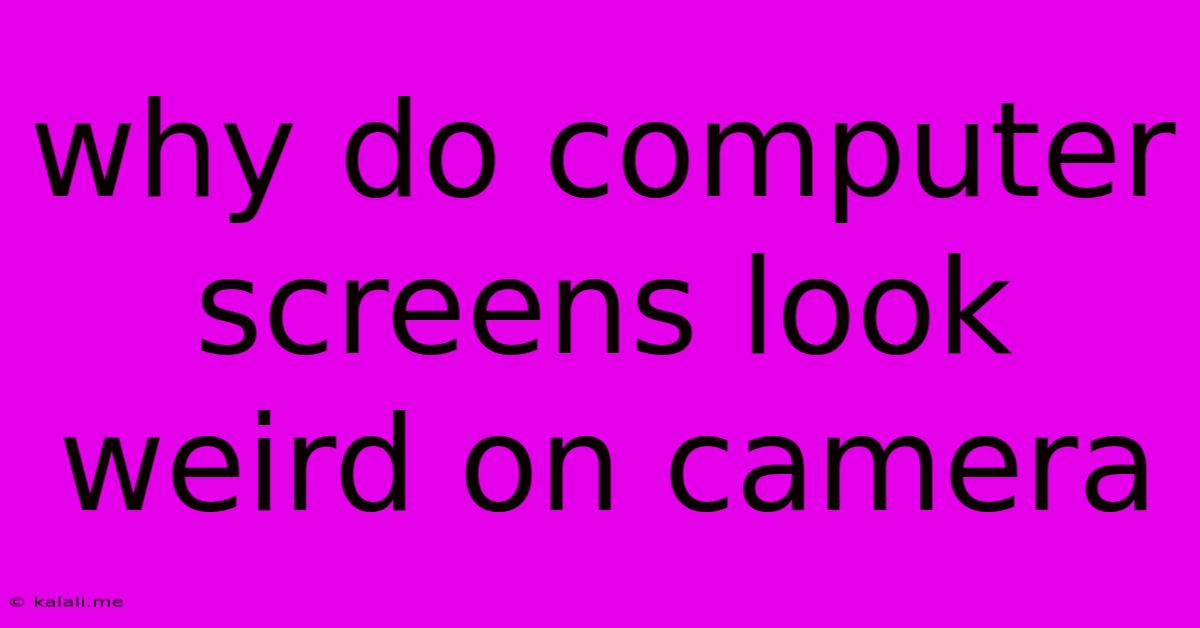Why Do Computer Screens Look Weird On Camera
Kalali
May 30, 2025 · 3 min read

Table of Contents
Why Do Computer Screens Look Weird on Camera? The Mystery of the Mirrored Display
Ever tried to record a tutorial or video conference only to find your computer screen looking strangely distorted or mirrored on camera? It's a frustratingly common problem, leaving your videos looking unprofessional and confusing. This article unravels the mystery behind this visual quirk, explaining the science behind the strange reflections and offering solutions to achieve a clear, crisp screen capture.
This issue isn't about faulty hardware; it's a fundamental interaction between how screens display images and how cameras capture them. Understanding this interaction is key to solving the problem.
The Root of the Problem: Reflections and Camera Angles
The weird effect on camera primarily stems from screen reflections. Computer screens, particularly LCD and LED screens, are reflective surfaces. When your camera records, it captures not only the image displayed on the screen but also the reflection of the camera lens itself, along with the surrounding environment. This creates a distorted and often mirrored image. This is particularly noticeable at certain angles.
Think of it like looking at a window: depending on the angle, you might see the reflection of yourself or the view outside. Similarly, the camera’s perspective captures various reflections from your screen, leading to the distorted image.
Different Screen Types, Different Challenges
While all screens are susceptible, the effect varies depending on the type of screen:
- Glossy screens: These are more prone to reflections, exacerbating the issue. The shiny surface amplifies the reflections, making the screen content nearly impossible to capture clearly.
- Matte screens: These screens offer better anti-glare properties, minimizing reflections and resulting in a clearer image on camera. However, they aren't immune to the problem entirely.
Factors Influencing Screen Appearance on Camera
Several factors contribute to this distortion beyond the screen type itself:
- Camera Angle: The angle at which the camera is positioned relative to the screen significantly impacts the reflections. Experimenting with different angles can minimize the mirrored effect. A slight tilt or offset can often make a huge difference.
- Lighting: Strong light sources reflecting off the screen intensify the problem. Proper lighting, minimizing direct light sources hitting the screen, improves the result. Soft, diffused lighting is generally best.
- Screen Resolution and Quality: A high-resolution screen with excellent color reproduction will generally produce a better onscreen image when captured. However, this does not eliminate the reflections entirely.
- Camera Quality: A higher-quality camera with better image processing capabilities might handle reflections slightly better, but it won't solve the fundamental issue.
Solutions and Workarounds
While a completely reflection-free screen capture might be impossible in some setups, here are some strategies to improve the quality:
- Adjust Camera Angle: Experiment with positioning your camera slightly above or below the screen. A small change can significantly reduce the mirrored effect.
- Improve Lighting: Use soft, diffused lighting to minimize harsh reflections. Avoid placing bright lights directly behind or in front of your screen.
- Screen Capture Software: Dedicated screen recording software often provides more control over image capture, allowing for better results than using a camera directly. These applications can sometimes compensate for some reflections.
- Use a Matte Screen Protector: Applying a matte screen protector can reduce reflections on glossy screens, significantly improving the onscreen image during recording.
- External Monitor: If possible, use an external monitor instead of the laptop screen. External monitors often have better viewing angles and less reflective surfaces.
By understanding the underlying cause and implementing these solutions, you can significantly improve the appearance of your computer screen on camera, ensuring your videos are clear, professional, and easy to watch. Remember, experimentation is key to finding the optimal setup for your specific environment and equipment.
Latest Posts
Latest Posts
-
Apps With Cloud Symbol Wont Download
May 31, 2025
-
Why Is My Washer Using Hot Water On Cold Setting
May 31, 2025
-
How Early Should You Arrive To A Wnba Game
May 31, 2025
-
Fallout 4 Can Nick Valentine Go In The Brotherhood
May 31, 2025
-
How To Set Margins In Latex
May 31, 2025
Related Post
Thank you for visiting our website which covers about Why Do Computer Screens Look Weird On Camera . We hope the information provided has been useful to you. Feel free to contact us if you have any questions or need further assistance. See you next time and don't miss to bookmark.